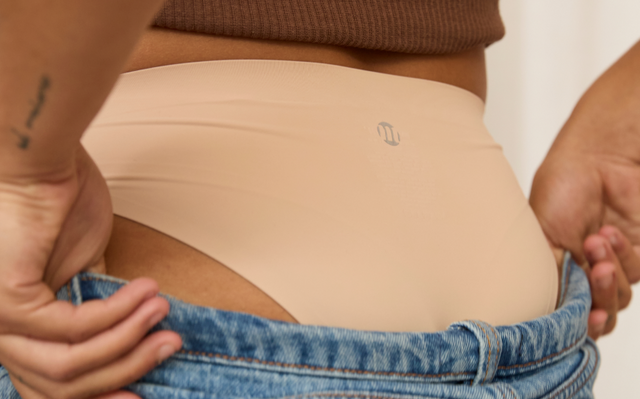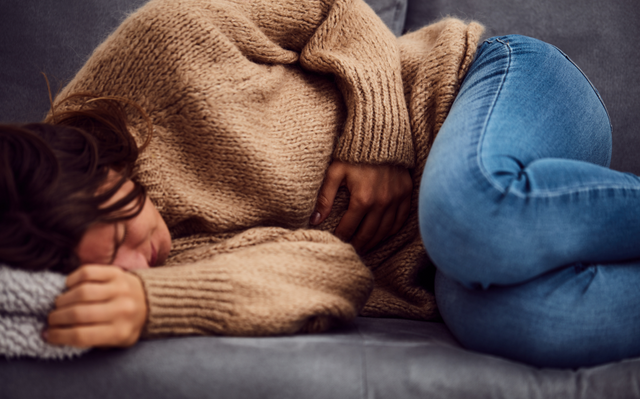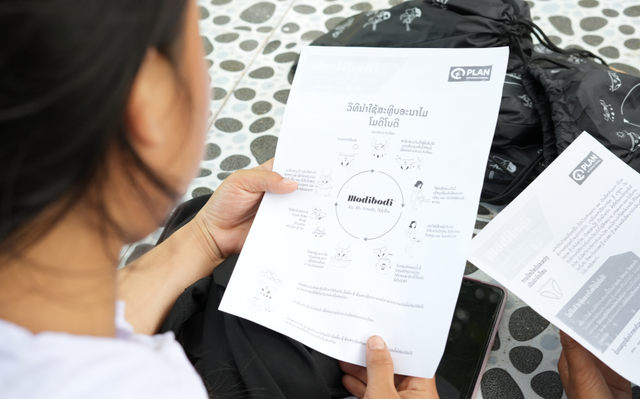Menstruations- und Eierstockzyklus 101: Was in Ihrem Körper passiert.
Möchten Sie mehr über Ihren Menstruationszyklus und Eierstockzyklus erfahren? Wir bei Modibodi legen großen Wert darauf, die Funktionsweise unseres Körpers zu verstehen.
Kurz gesagt: Der Menstruationszyklus ist ein natürlicher Prozess, der den Körper auf eine Schwangerschaft vorbereitet. (Und wie Sie vielleicht schon vermutet haben, passiert er unabhängig davon, ob Sie ein Baby planen oder nicht.) Wenn Sie nicht schwanger werden, signalisieren Ihre Hormone Ihrer Gebärmutter, ihre Gebärmutterschleimhaut abzustoßen. Dies löst Ihre Periode aus. Sobald Ihre Periode einsetzt, beginnt der Zyklus von neuem.
Doch wie wir noch sehen werden, geht es dabei um viel mehr als nur Ihre Periode.
Die 4 Phasen des Menstruationszyklus
Ihr Menstruationszyklus durchläuft vom Tag Ihrer Periode bis zum ersten Tag Ihrer nächsten Periode vier wichtige Phasen. Der Eierstockzyklus beschreibt die Vorgänge in Ihren Eierstöcken während des Menstruationszyklus.
Im Durchschnitt dauert ein Menstruationszyklus 28 bis 29 Tage, seine Länge und Intensität können jedoch von Person zu Person variieren.
Folgendes passiert in jeder Phase in Ihrem Körper.
Menstruationsphase (dauert 3–7 Tage)
Wenn eine Eizelle aus Ihrem vorherigen Zyklus nicht befruchtet wurde, stößt Ihr Körper die verdickte Gebärmutterschleimhaut ab, die die Eizelle nährte. Dieses Abstoßen ist für viele von uns die sogenannte Periode.
Der Beginn des Menstruationszyklus wird mit dem Einsetzen Ihrer Periode (bestehend aus Blut, etwas Schleim und Gewebe) durch Ihre Vagina markiert.
Follikelphase (dauert 11–27 Tage)
Die Follikelphase beginnt parallel zur Menstruationsphase, d. h. sie überschneidet sich mit den frühen Stadien Ihrer Periode. Während dieser Phase schüttet Ihr Gehirn das follikelstimulierende Hormon (FSH) aus, das Ihre Eierstöcke zur Produktion kleiner Bläschen, der sogenannten Follikel, anregt. In jedem Follikel befindet sich eine unreife Eizelle.
Normalerweise kann nur die stärkste und gesündeste Eizelle heranwachsen (manchmal schaffen es aber auch zwei). Während die Eizelle reift, steigt Ihr Östrogenspiegel und Ihre Gebärmutterschleimhaut wird dicker.
Eisprungphase (dauert 16 bis 32 Stunden)
Der steigende Östrogenspiegel regt nun Ihr Gehirn zur Ausschüttung des luteinisierenden Hormons (LH) an, und der Eisprung beginnt. Die reife Eizelle verlässt den Eierstock und wandert durch den Eileiter in Richtung Gebärmutter, in der Hoffnung, dort mit einem Spermium zu kollidieren.
Der Eisprung findet in der Regel in der Mitte Ihres Zyklus statt, einige Wochen vor Ihrer nächsten Periode. Einige verräterische Anzeichen für einen Eisprung sind:
- Ein leichter Anstieg der Basaltemperatur (Ihrer Ruhetemperatur)
- Dickflüssiger Ausfluss in der Unterwäsche (ähnlich der Konsistenz von Eiweiß)
- Er ist nicht der Typ fürs Warten, denn wenn die Eizelle nicht innerhalb eines Tages befruchtet wird, zerfällt sie.
Lutealphase (dauert 11 bis 17 Tage)
In der Lutealphase führt Ihr Körper eine Art hormonellen Schwangerschaftstest durch. Nach dem Eisprung verwandelt sich der Follikel, der die Eizelle freigesetzt hat, in eine Struktur namens Corpus luteum. Diese temporäre Drüse schüttet das Hormon Progesteron sowie etwas Östrogen aus, um die Gebärmutterschleimhaut dick und eibereit zu halten.
Wenn Sie schwanger werden, beginnt Ihr Körper mit der Produktion von humanem Choriongonadotropin (hCG), das zur Erhaltung der Gebärmutterschleimhaut beiträgt. Es ist auch das Hormon, nach dem Schwangerschaftstests suchen.
Wenn Sie nicht schwanger werden, verschwindet der Gelbkörper wieder im Körper und Ihr Östrogen- und Progesteronspiegel sinkt, was Ihre Periode auslöst. Wenn Sie Symptome des prämenstruellen Syndroms (PMS) bekommen, treten diese in der Regel zu diesem Zeitpunkt auf.
Mehr zu Hormonen
Hormone sind das Herzstück des Menstruationszyklus. Stellen Sie sie sich als chemische Botenstoffe vor, die den einzelnen Teilen Ihres Fortpflanzungssystems zum richtigen Zeitpunkt grünes Licht geben.
Wie wir herausgefunden haben, gibt es eine Reihe von Hormonen (wie FSH, LH und hCG), die in jeder Phase deines Zyklus zusammenwirken, um die Fruchtbarkeit zu ermöglichen. Aber fordern Sie heraus, ein ikonischeres Duo als Östrogen und Progesteron zu nennen. Diese vielbeschäftigten Hormone sind für ihre Rolle im Menstruationszyklus bekannt, leisten aber noch viel mehr für die allgemeine Gesundheit sowohl menstruierender als auch nicht menstruierender Körper.
Was Östrogen bewirkt
Östrogen spielt eine wichtige Rolle bei der sexuellen und reproduktiven Entwicklung während der Pubertät. Es sorgt außerdem für einen reibungslosen Menstruationszyklus und unterstützt Fruchtbarkeit und Schwangerschaft.
Darüber hinaus hilft Östrogen:- Sorgen Sie für einen gesunden Cholesterinspiegel
- Knochenschwund vorbeugen
- Reduzieren Sie die Auswirkungen der Hautalterung
- Sorgen Sie für eine optimale Gehirn- und Herzfunktion
Wenn Sie vor Ihrer Periode gereizt, ängstlich oder weinerlich sind, sollten Sie wissen, dass es einen Zusammenhang zwischen Menstruationszyklushormonen und Ihrer Stimmung gibt. Manchmal kann ein niedriger Östrogenspiegel in der Luteal- und Menstruationsphase PMS-Symptome wie Stimmungsschwankungen auslösen.
Was Progesteron bewirkt
Kurze Zusammenfassung: Erinnern Sie sich an die provisorische Drüse aus Ihrer Lutealphase? Die, die wie ein Zauberspruch klingt? Sie (der Gelbkörper) produziert das Steroidhormon Progesteron, um Ihre Gebärmutter auf eine Schwangerschaft vorzubereiten.
Bleibt Ihre Eizelle unbefruchtet, sinkt Ihr Progesteronspiegel und Ihre Periode setzt ein. Wird die Eizelle befruchtet, beginnt das Progesteron zu wirken und unterstützt Ihre Gebärmutter bei der Ernährung des sich entwickelnden Fötus.
Progesteron fördert das Wohlbefinden auf vielfältige Weise, trägt zur Stärkung der Knochen bei, fördert einen erholsamen Schlaf und beugt Depressionen vor.
Bei menstruierenden Körpern kann ein Mangel an Progesteron zu Folgendem führen:
- Inkonsistente oder ausgelassene Perioden
- Ungewöhnliche Perioden
- Erhöhte Östrogenspiegel (die zu Libidoverlust, Gewichtszunahme und Gallenblasenproblemen führen können)
- Schmierblutungen und Bauchschmerzen in der Schwangerschaft
- Wiederholte Fehlgeburten
7 Dinge, die Ihren Zyklus durcheinander bringen können
Der menschliche Körper ist so einzigartig wie ein Fingerabdruck. Jeder Zyklus ist anders und kann sich in jeder Lebensphase aus vielen Gründen verändern.
Zu den bekannten Störungen des Menstruationszyklus und des Eierstockzyklus gehören:
- Schwangerschaft. Der OG-Störer: Eine Schwangerschaft sollte Ihre Periode stoppen.
- Geburtenkontrolle. Verhütungsmittel wie die Pille können die Periode verkürzen, abschwächen oder sogar ganz ausbleiben lassen.
- Uterusmyome. Diese nicht krebsartigen Wucherungen können in Ihrer Gebärmutter auftreten und Ihre Periode stärker und länger machen.
- Polyzystisches Ovarialsyndrom (PCOS) . Dieses hormonelle Ungleichgewicht unterbricht die Entwicklung einer Eizelle in den Eierstöcken und kann Menstruationsunregelmäßigkeiten auslösen.
- Hartnäckiges Training. Zu viel intensives Training kann dazu führen, dass Ihre Periode ausbleibt.
- Gewichtsveränderungen. Gewichtsveränderungen können den Östrogenspiegel beeinflussen. Überschüssiges Fett oder ein schneller Gewichtsverlust können manchmal zu starken, ausbleibenden oder unregelmäßigen Perioden führen.
- Stress. Hoher Stress kann zu schmerzhaften Perioden, unregelmäßigen Blutungen und Fruchtbarkeitsproblemen führen.
Von Hormonschwankungen über Stillen, Schlafstörungen bis hin zu gesundheitlichen Problemen gibt es viele Gründe, warum Ihr Zyklus vom normalen Rhythmus abweichen kann. Wenn Sie sich Sorgen machen, wenden Sie sich am besten an Ihren Hausarzt.
Was ist Menstruationsurlaub?
Menstruationsurlaub ist eine Form von Freistellung am Arbeitsplatz, bei der Arbeitnehmerinnen aufgrund menstruationsbedingter Symptome (wie PMS) eine Auszeit nehmen können. In Australien setzt sich eine Gruppe von Gewerkschaften dafür ein, Menstruationsurlaub in das Fair Work Act aufzunehmen.
Wenn Sie jemals unter unangenehmen Menstruationsbeschwerden wie Krämpfen, Kopfschmerzen oder Übelkeit gelitten haben und es einfach nicht ins Büro oder sogar an Ihren Homeoffice-Schreibtisch geschafft haben, sind Sie nicht allein. Im Jahr 2021 waren 40 % der 125.000 Verdammt große Umfrage Teilnehmerinnen gaben an, sich wegen ihrer Periode krankgemeldet zu haben.
Wenn es den Gewerkschaften gelingt, den Menstruationsurlaub in Australien gesetzlich zu verankern, erhalten die Arbeitnehmerinnen einen Tag bezahlten Urlaub pro Monat. Wir drücken ihnen die Daumen, vor allem wenn man bedenkt, dass 77 % der australischen Frauen sagen, dass Regelschmerzen ihre Arbeitsfähigkeit beeinträchtigt haben.
Mittlerweile führen einige Unternehmen eigene Regelungen für den Menstruationsurlaub ihrer Mitarbeiter ein. Und Modibodi ist natürlich stolz darauf, dazuzugehören.
Lernen Sie Ihren Menstruationszyklus noch besser kennen
Hoffentlich kennst du dich jetzt besser mit deinem Menstruationszyklus und seinen einzelnen Phasen aus. Und wenn du jetzt mehr Fragen hast als zu Beginn des Lesens, ist das kein Problem!
Obwohl er manchmal (buchstäblich) lästig sein kann, ist unser Zyklus ein faszinierender, komplexer Prozess, der einer genaueren Untersuchung bedarf. Erfahren Sie mehr über die Einzelheiten auf der Modibodi-Blog .







